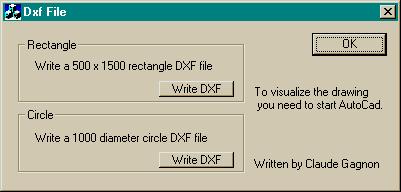This
article demonstrate how to write an ASCII DXF
files. A DXF file
is a file composed
of sections and associated values. They are read by AutoCad
and then converted to a drawing.
I have
developped a class CDxf to write
a DXF file from an application. Then the user must use
AutoCad to
interpret the DXF file.
I have
included only a small portion of what can be do with DXF
files. All the details are contained in the
following document from the AutoDesk web site : http://www.autodesk.com/techpubs/autocad/dxf/.
// Here is the code to write a DXF file that will draw a circle in AutoCad.
//
void CDxf::Circle ()
{
// 1000 diameter circle
// Creation of an output stream objet in text mode.
// ios::app : append
ofstream FichierDxf ("TestDxf.dxf", ios::app);
// Draw the circle
FichierDxf << 0 << endl;
FichierDxf << "CIRCLE" << endl;
FichierDxf << 8 << endl; // Group code for layer name
FichierDxf << 0 << endl; // Layer number
FichierDxf << 10 << endl; // Center point of circle
FichierDxf << 0.0 << endl; // X in OCS coordinates
FichierDxf << 20 << endl;
FichierDxf << 0.0 << endl; // Y in OCS coordinates
FichierDxf << 30 << endl;
FichierDxf << 0.0 << endl; // Z in OCS coordinates
FichierDxf << 40 << endl; // radius of circle
FichierDxf << 500.0 << endl;
FichierDxf.close();
}
By being
able to write a DXF file,
I can integrate into my applications a way to share
information with AutoCad. Obviously there is a lot
more that can be added to this class.



